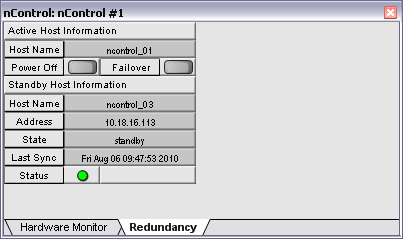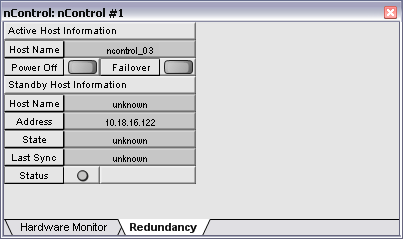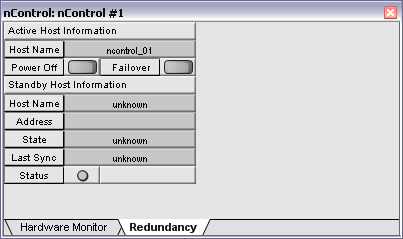The nControl redundancy system allows a standby unit to replace an active unit on the network if it stops functioning.
When the system is used, the configuration settings from the active unit are automatically copied to the standby unit to keep them synchronized. The two units are responsible for a single role.
Note: In order to use the redundancy system, you must configure the units via the web interfaces before you use them in your project. For more information, see Setting up redundancy in the nControl Hardware Manual.
The explanations below assume that you have already added an nControl device to your project.
|
In this section |
See also |
When you deploy the project, you will see the active nControl unit listed on the Role Deployment dialog box, but the standby unit will not be listed. When you deploy the project to the active unit, the Redundancy tab on the nControl device will show the host name of the active unit under Active Host Information. The name and IP address of the standby unit will be displayed under Standby Host Information.

If the active unit fails, after a short delay, the standby unit will start hosting the role; under Active Host Information, the Host Name field will change to show the name of the standby unit; and under Standby Host Information, the Address field will show the IP address of the unit that has just failed.

If the failed unit starts functioning, its details will be shown under Standby Host Information. It will not resume hosting the role.
When you deploy the project, you will see the active nControl unit listed on the Role Deployment dialog box, but the standby unit will not be listed. When you deploy the project to the active unit, the Redundancy tab on the nControl device will show the host name of the active unit under Active Host Information, but the Standby Host Information section will not show information from the standby unit.

If the active unit fails, after a short delay, the standby unit will start hosting the role; under Active Host Information, the Host Name field will change to show the name of the standby unit; and under Standby Host Information, the Address field will show the IP address of the unit that has just failed.

If the failed unit starts functioning, it will resume hosting the role and, under Active Host Information, the Host Name field will change to show the name of the unit that was originally hosting the role. The unit that is now back in standby mode will be restarted.